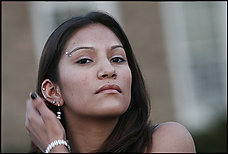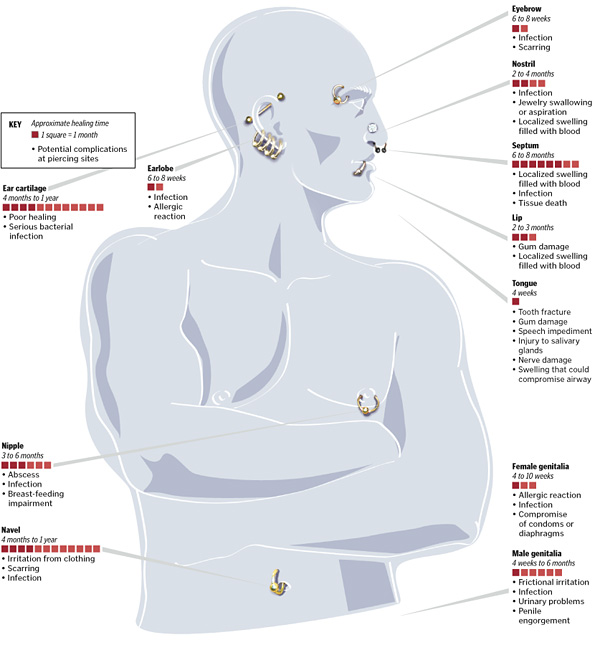 |
 |
 |
 Health & Beauty | November 2006 Health & Beauty | November 2006  
The Hole Truth
 Sandra G. Boodman - Washington Post Sandra G. Boodman - Washington Post


| | When Marymount University student Alicia Funderburg, 18, had her tongue pierced last year, the 10-second procedure didn't hurt. But soon she experienced swelling and pain that lasted for a few weeks. (Susan Biddle - Twp) |
When it comes to body piercing, the formerly fringe procedure that has moved into the mainstream, medical experts have a message: Don't try this at home. Or maybe at all.

Those warnings by groups representing dermatologic surgeons, dentists and other medical authorities have acquired new urgency after two cases in which teenage girls nearly died as a result of infections they developed from botched piercings.

Three weeks ago Indiana surgeons removed the breast of an 18-year-old diabetic whose torso was invaded by flesh-eating bacteria surrounding the nipple rings she acquired at a salon to celebrate her birthday. A few days later a Boston mother was sentenced to 18 months in prison for failing to seek medical attention for her 13-year-old daughter, who suffered major organ damage from an infection that resulted after the girl pierced her own belly button.

Other reports in medical journals include a sewing needle that disappeared during a do-it-yourself tongue piercing and had to be extracted by oral surgeons; a variety of serious, drug-resistant bacterial infections; hepatitis and tetanus; fractured teeth and nerve damage from tongue studs; as well as permanent scarring.

"People think it's hip and cool, but they don't realize that it's not like getting your ears pierced," said Eugene Giannini, president of the D.C. Dental Society, who, like the American Dental Association, opposes oral piercings. Giannini said he has seen gum damage and speech problems among his nearly two dozen patients who have tongue studs. "I think people need to be informed consumers if they're going to have it done."

For nearly half a century, earlobe piercing - one hole in each ear - has been a rite of passage for American teenage girls. In the past decade, the practice of using a needle to make tiny holes in the upper ear, nose, tongue, lip, eyebrow, nipples or even genitals for the purpose of wearing body jewelry has become more common, doctors say, particularly among those under 30.

For some wearers, piercing is a statement of rebellion or of self-expression; for others the adornment is purely decorative. Body piercing is widespread in some cultures.

It's impossible to determine how many Americans have piercings - or how many have problems as a result. A study published two months ago in the Journal of the American Academy of Dermatology involving more than 500 participants between 18 and 50 found that 24 percent had tattoos and 14 percent had piercings other than in an earlobe. Piercings were more common among women.

"It's become remarkably popular," said Jeffrey S. Dover, a dermatologic surgeon in Boston who says he routinely sees patients, most of them young and female, sporting hoops on their upper ears, barbell-shaped tongue studs or jeweled navel rings. "A lot of my nursing staff have them," he added, attributing the popularity in part to the influence of numerous celebrities with piercings, among them Britney Spears, Lindsay Lohan, Tommy Lee and Dennis Rodman.

Twenty years ago, observed Dover, who is affiliated with the Yale University School of Medicine, it was rare to see a man wearing an earring. These days many professional football players sport at least one glittery diamond stud the size of a nickel.

Those under 30 are not the only devotees of piercing, said Doris J. Day, a cosmetic dermatologist who practices on Manhattan's posh Upper East Side. "I do skin cancer checks on my patients every year, and some of the most buttoned-down CEO types - people you'd never expect to have piercings - have them where you least expect it," said Day, who estimates that at least 50 of her patients wear jewelry in places other than the earlobe.

Risky Business

Donna I. Meltzer, an associate professor of family medicine at the State University of New York at Stony Brook, said she became interested in the subject about seven years ago after treating a spate of pregnant women with infections from navel rings - and could find virtually nothing in the medical literature.

"I sort of became an expert by default," said Meltzer, author of a widely cited article about the complications of body piercing published last year in the journal American Family Physician.

Meltzer, who said she is "neither for it nor against it," said she believes many patients don't appreciate the risks of piercing - or realize that it leaves a permanent hole in the skin that doesn't close even after jewelry is removed. Most piercings are performed with a needle and without anesthetic, although sometimes a topical numbing agent such as lidocaine is used.

Doctors say that while pierced earlobes sometimes become infected, other sites are more often prone to complications because they tend to be subjected to friction or continuous moisture, which can contribute to the growth of bacteria. In other areas, such as the cartilage in the upper ear, the lack of blood vessels can retard healing. And the mouth is teeming with bacteria.

Meltzer said she is particularly concerned about the lack of sterility in some tattoo parlors, where many piercings are performed; the proliferation of teenage "piercing parties" where booze is used as an anesthetic; and, in most states, the lack of regulation of an invasive procedure capable of transmitting HIV and other blood-borne diseases. (The District has no regulations governing piercing, officials say. Virginia prohibits piercing of minors without parental consent, while neither Virginia nor Maryland requires routine inspection of shops performing piercing.)

John Rowan, a registered nurse who owns Rendezvous Tattoo and Body Piercing, one of at least five such shops in Blacksburg, Va., home of Virginia Tech, said he thinks the dangers are exaggerated.

"I don't think there have to be any medical risks at all if it's done correctly," said Rowan, who charges $50 for a nostril piercing - one of the most popular adornments - and has several piercings himself. "You've got to remember that the medical community only sees the downside. For every one infection they see, there are 1,000 that are trouble-free. Nobody comes into the ER to tell you how great their piercing is."

Rowan, who said he has pierced the navels of girls as young as 12 who were accompanied by their parents, said he thinks more regulatory oversight is needed. Many piercers, noted Rowan, a member of the nonprofit Association of Professional Piercers, learn the craft by apprenticing at a studio. And in Virginia, he notes, body piercers come under the jurisdiction of the board that regulates barbers, not the health department.

Fashion Statement

Lax regulation and potential risks were not uppermost in the mind of 19-year-old Sarah Mutnick, a sophomore at George Mason University, when she had her navel pierced at 17 in a nail salon near Potomac Mills Mall. After developing an infection caused by friction from her spandex high school field hockey uniform, she removed the jewelry. She got her second navel ring for her 18th birthday.

Body piercing, Mutnick said, is "a fashion statement - something for the here and now - not when I'm 30." Among her friends and classmates, she said, it is widely accepted and popular among the sorority girls at her school. Her boyfriend had a tongue stud, she said, her roommate just got her nose pierced, and her older brother wears an earring.

Mutnick said her parents were not opposed to her navel ring, "but my grandma doesn't understand it. She said, 'Didn't it hurt?' " Mutnick, who also has multiple ear piercings, said the major discomfort she experienced occurred when she caught the ring on her car trunk.

"I fell on the ground crying" because the pain was so intense, she recalled.

Alicia Funderburg, 18, said she decided to have her tongue pierced last year while attending John F. Kennedy High School in Montgomery County. She didn't go to a studio, but arranged with a friend to have a man who had pierced many of their classmates do it at a friend's home.

She said she had a few reservations, "but my friend and I sort of interrogated him and he said he'd done over 1,000 people," recalled Funderburg, who now attends Marymount University in Arlington.

The procedure, she said, was performed without anesthesia, took about 10 seconds and didn't hurt at first. The pain came later.

"My tongue swelled up and then turned black and blue, and it was very hard to talk," she recalled. "I had to chew all the way in the back of my mouth for weeks."

Funderburg said that when her mother spotted the tongue stud several months later, she was upset.

"I told her I was thinking of getting one on my nose, but she said, 'No more piercings,' " Funderburg recalled. "I know my mom thinks it's a form of mutilation, but it's not. It's a matter of self-expression." The only downside of her eyebrow ring is that she had to remove it for her job, which has a no-facial-piercings policy.

Funderburg said she has not had problems with her tongue stud but occasionally catches the barbell-shaped jewelry on a fork while eating.

There is one area Funderburg said she has no intention of piercing: her genitals, as one of her friends did.

"No way," Funderburg said. "Absolutely not."
The Price of Piercing - While body piercing has increased in popularity and social acceptance, long healing time, infections and scarring can plague those who pierce.

 | 
 | |
 |



